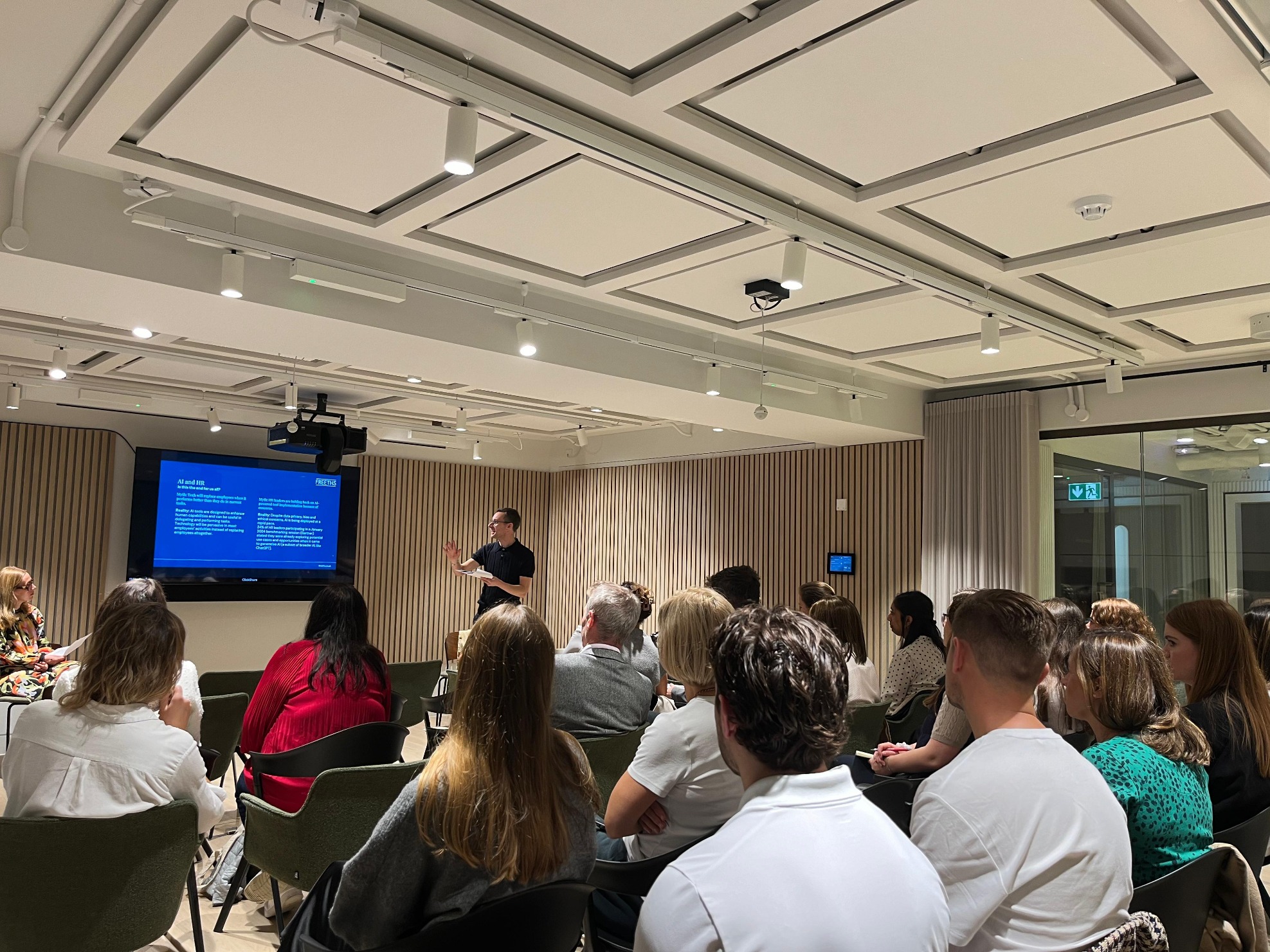AI & Employment Law: HR Seminar
We were thrilled to be once again co-hosting a Seminar for our HR community with Kevin Poulter and Freeths LLP. We would like to thank everyone who attended for your active participation and for helping to bring the conversation to life. It was also great to see firsthand the impact of networking opportunities for like-minded HR professionals.
Kevin opened the session with an AI-generated introduction that effectively set the stage for our discussions. He delved into how we subconsciously enhance AI’s accuracy and knowledge through simulated learning. Understanding AI as a learned software is crucial for recognising its potential to streamline processes, generate reports and produce content based on previously acquired knowledge. One of AI’s most significant benefits for businesses is its ability to simplify complex processes and manage vast data reports. With this, larger organisations, equipped with the best AI software and intricate dashboards, stand to gain the most from these advancements.

AI can also be hugely important in streamlining the recruitment process for organisations. From drafting job adverts and descriptions to screening CVs and transcribing interviews, AI can save hiring managers considerable time. For instance, job adverts can be created and amended in seconds, significantly reducing the administrative burden on recruiters. In client-led markets or particularly high-volume roles, automated initial screenings and responses can enhance the candidate journey by ensuring all applicants receive timely feedback. Moreover, AI can actively participate in the recruitment process by conducting brief initial calls, functioning as chatbots and transcribing interviews, further streamlining operations.
However, the implementation of AI in recruitment also presents business-critical risks that must be considered and addressed. While AI has the potential to reduce personal bias, it can inadvertently perpetuate historical discrimination. For example, if past hires predominantly reflect a certain demographic, AI may reinforce this pattern in future screenings and prefer candidates who share similar traits and backgrounds. This highlights the importance of vigilance in how AI algorithms are trained and applied. Additionally, candidates are becoming increasingly resourceful, using tactics like “white ink” to manipulate their CVs, ensuring they get past AI screening despite lacking the requisite experience. This could lead to hiring managers spending time on unqualified candidates.

The use of AI in employee lifecycle processes offers, again, a mix of opportunity and challenge. For resource-limited teams, AI can significantly streamline tasks such as transcribing meeting notes, writing contract changes and amending HR policies. However, caution is advised, particularly with sensitive meetings like disciplinary procedures. Recording or transcribing these discussions verbatim may alter the behaviour of employees or employers and reduce the consultative nature of the process. Clients have shared their experiences with generative AI for creating HR templates, such as policies and contracts. Yet, as with the motif throughout, those in attendance who do use AI, will ensure it serves as a draft-tool, to be reviewed by the human eye before release.
Kevin wrapped up the seminar by outlining best practices for HR professionals to mitigate risks associated with AI in the workplace. It is vital to approach AI use with intention, clearly defining objectives and gathering feedback from peers or networks regarding successful software and processes. While there is currently no legal obligation to inform employees about AI use, it is considered best practice to communicate where appropriate, consult about its implementation where possible and offer an opt-out option. Given the generational divide and disparities in access to technology, organisations must ensure that all employees feel comfortable and informed about AI tools. Establishing clear guidelines and accountability structures is essential for ensuring that AI is used ethically and effectively. This includes safeguarding intellectual property and ensuring that sensitive information is not inadvertently shared and stored through AI platforms without proper authorisation and control.

By championing clarity about how and when AI is utilised in recruitment and employee lifecycle processes, organisations can ensure that necessary checks and inputs are in place. This proactive approach will help mitigate biases and time pressures, ultimately allowing AI to be a valuable ally in the workplace. As we continue to navigate this transformative landscape, open dialogue and collaboration among HR professionals will be key to harnessing the full potential of AI.
If you have any questions regarding hiring or training, please reach out to the C&C team For more information on Employment Law changes, please contact Kevin and the Freeths Employment Team.
For more thoughts on the topic, Kevin recommends the Understand: Tech and AI podcast available from BBC Sounds.
Get in touch with us:
For C&C Academy, EA/PA, HR, and Business Support recruitment, contact philippa@candcsearch.co.uk
For keynotes, training, workshops, and group coaching, contact lucy@candcsearch.co.uk
#AIInHR #EmploymentLaw #HRTechnology #RecruitmentAutomation #AIInRecruitment #EmploymentLawSeminar #HRCompliance #WorkplaceAI #HRCommunity #AIAndBias #HRBestPractices #HumanResources #EmployeeLifecycle #FreethsLLP #CAndCSearch #KevinPoulter #AIEthics #DataDrivenHiring #HRProfessionals #HRNetworking #WorkplaceInnovation #RecruitmentTech #HRStrategies #BusinessCompliance #EmploymentBestPractices #TalentManagement #HRTrends #HRLeadership #AIinBusiness #WorkplaceWellbeing #LondonRecruitment #HRSupport #HRTips #EmployeeExperience









